Powder coating, with its evolving colour, decorative, and aesthetic effects that imitate natural surfaces and improve both the appearance and the functional performance of the treated components, is increasingly the preferred choice of architects and designers for finishing architectural elements, such as metal cladding. That is also thanks to the collaboration and joint experimentation between metal panel manufacturers and powder coating manufacturers. In this article, we recount the professional partnership between Emboss Panels, a specialist in the production of metal panels with three-dimensional effects, and TIGER Coatings, which supplies it with special-effect, matte and flat matte, metallic, and anodised-like powder coatings to enrich its products’ sculpted surfaces.
A cladding system is like a skin that protects, decorates, and enhances the underlying material and its shapes. Cladding can be used to accentuate the modernity of a building or room, to curb, contain, and screen light for specific visual effects, to protect an area or isolate it thermally and acoustically, to enhance aesthetics and beauty, and to improve the sustainability and durability of a structure or component. Thanks to its versatility in terms of shapes, materials (it can be made of wood, metal, or composites), and finishes, cladding is one of the most powerful tools for architects and designers to create exclusive, distinctive structures with a soul.
Sculptured surfaces for architecture
“Sculptured surfaces for architecture”: this is the evocative definition that Emboss (Tezze sul Brenta, Vicenza, Italy), a manufacturer of decorative panels for architecture and interior design founded in 2018, gives of its products.
This company represents the combination of different souls into a refined and exclusive solution for exterior and interior cladding, as it has designers and craftspeople work together to create metal panels with striking decorative effects. Emboss serves architects, designers, installers, distributors, and end users who want to customise their projects with exclusive, attractive-looking panels. Its innovative manufacturing process allows deforming metal sheets to ultimately offer three-dimensional surfaces with vibrant, multiform effects. “At its foundation, our company was focused on technical design,” says Cesare Zilio, the engineer who established Emboss, “as it was originally a design studio specialising in metal façade cladding. Over the years, however, we have increasingly dealt with the production aspects of metal cladding sheets, developing the concept of panels with three-dimensional effects. Experimentation with various manufacturing techniques has gradually led us to define an efficient and innovative process for producing 3D metal panels used for façade cladding, interior cladding, and suspended ceilings.”
Although such machining processes creating 3D effects through sheet metal deformation are already enough to make Emboss’ metal panels an extremely attractive, unique, and exclusive solution for architectural cladding, the paint products applied on them certainly contribute to further enhancing these effects. “Finishes must emphasise what Emboss has added to the simple metal sheet. They should also be as smooth as possible, as the tactile effect is already inherent in the three-dimensionality we give to the metal,” explains Zilio. “Since we prefer to use powder coatings, we choose to work with an industry leader, TIGER Coatings, not only for the quality of its powders but also for its technical support service, its laboratory’s assistance for testing and validation, and its willingness to experiment and formulate products with customised colours and effects.”
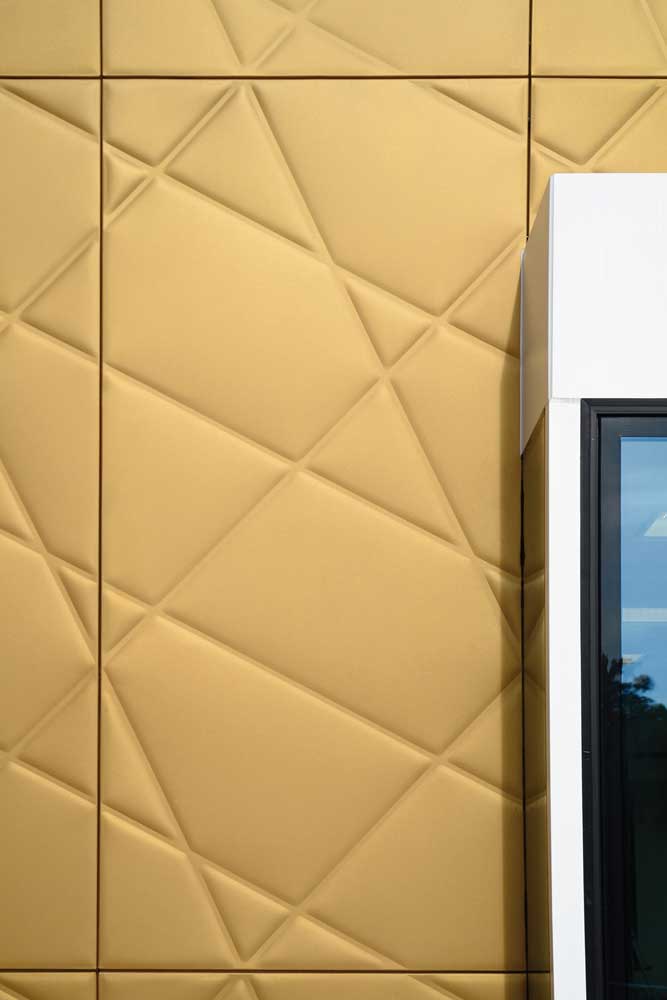 © Courtesy of Emboss
© Courtesy of Emboss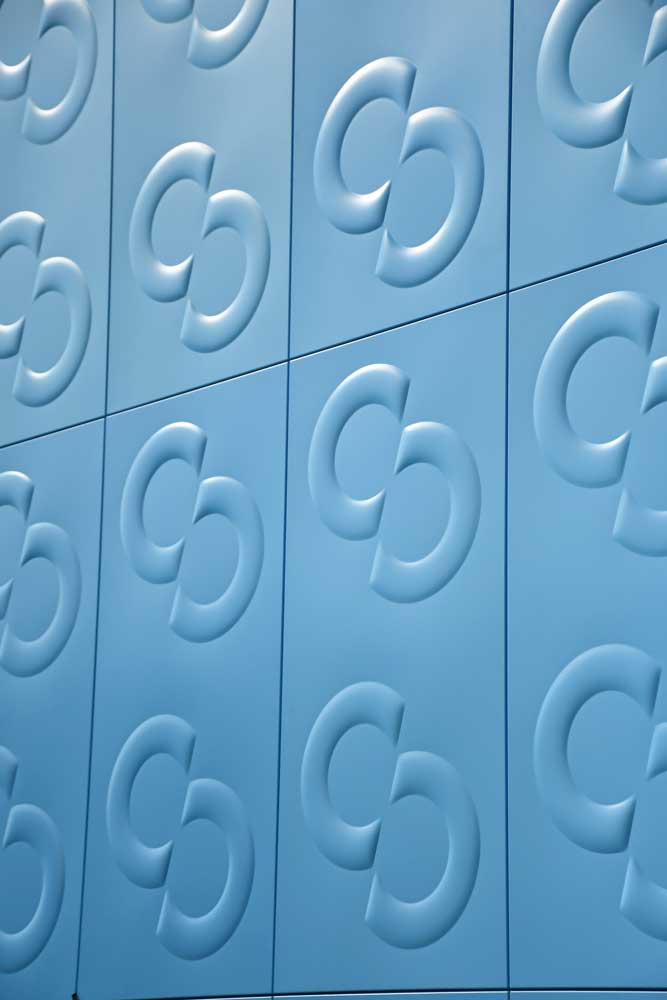 © Courtesy of Emboss
© Courtesy of EmbossSurfaces with a soul
“Emboss’ sculptured surfaces are decorations created with an exclusive production technique: each model is carefully designed and mechanically reproduced with a plastic deformation technique that combines craftsmanship and industrialisation. This workflow offers numerous opportunities: it is possible to process solid, perforated, or expanded metal sheets in aluminium, galvanised steel, stainless steel, brass, copper, and zinc-titanium (an alloy whose surface, under the action of the weather, becomes covered with a thin, self-protective layer that gives it a naturally ageing and aesthetically pleasing appearance, Ed.),” indicates Zilio. “Despite being a young company, we are able to supply finished panels ready to be installed, not only formed and coated but, if necessary, also folded and framed. Ideally, Emboss’ three-dimensional panels should be specified directly by designers: by conceiving a project with this type of cladding from the outset, both the aesthetic performance and the production costs can be optimised in terms of sheet division, modules, finishes, and so on.”
Emboss offers several standard patterns, as well as the possibility to customise the effects to make each project original and exclusive. “Our portfolio includes standard patterns such as Bumps, an organic water effect; Carapax, an organic effect similar to the previous one but with a denser pattern; Branch, a branching pattern that ensures continuity among panels; Line, with elegant linear stripes; Quilt, a soft, quilted effect; and Sand, with a wavy pattern reminiscent of dunes. At the same time, we place great importance on customisation. We give our customers the opportunity to create personalised designs, and this greatly enhances our offer,” states Cesare Zilio. “Emboss’ main strength is to have investigated lean manufacturing technologies to offer tailor-made solutions at attractive costs and even for small batches.”
All Emboss panels can be made in solid or perforated metal and decorated with different technologies, from anodising to powder or liquid coating, from electro-colouring to polishing and satin finishing. Thanks to these multiple combinations of substrates, effects, decorations, and cladding functions, Emboss’ panels are a very versatile decorative solution: they can be used both for exterior architectural applications such as façade cladding and roofing and for indoor applications such as false ceilings or wall cladding. Solid sheet metal panels are typically used for complete roofing systems, whereas perforated or expanded metal ones can be used to create transparencies and interplays of solids and voids, for example, in solar shading and ventilation systems.”
Powder coating: multiplying the decorative effects available
“Processing all types of metal sheets opens up the possibility of using different surface finishes to enhance each three-dimensional effect in its specific design context. We range from polished steel to satin-finished steel and from pre-anodised aluminium to coated aluminium, which makes up a large part of our volumes. For Emboss’ products, coating is a very flexible and useful finishing solution because it provides a vast range of colours, gloss levels, and special effects. Its only limitation is that it diminishes the metal surfaces’ gloss degree and cannot maintain the mirror effect, which is important for some patterns. Still, with TIGER’s experimentation and technical support, we can offer an excellent compromise between colour, effect, and gloss,” explains Cesare Zilio.
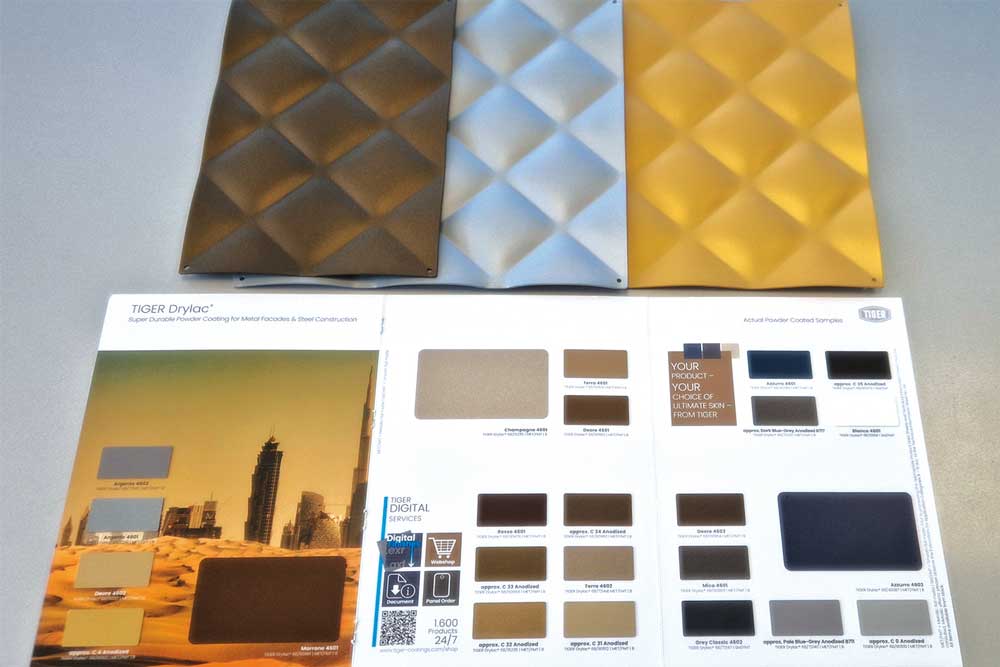 © ipcm
© ipcm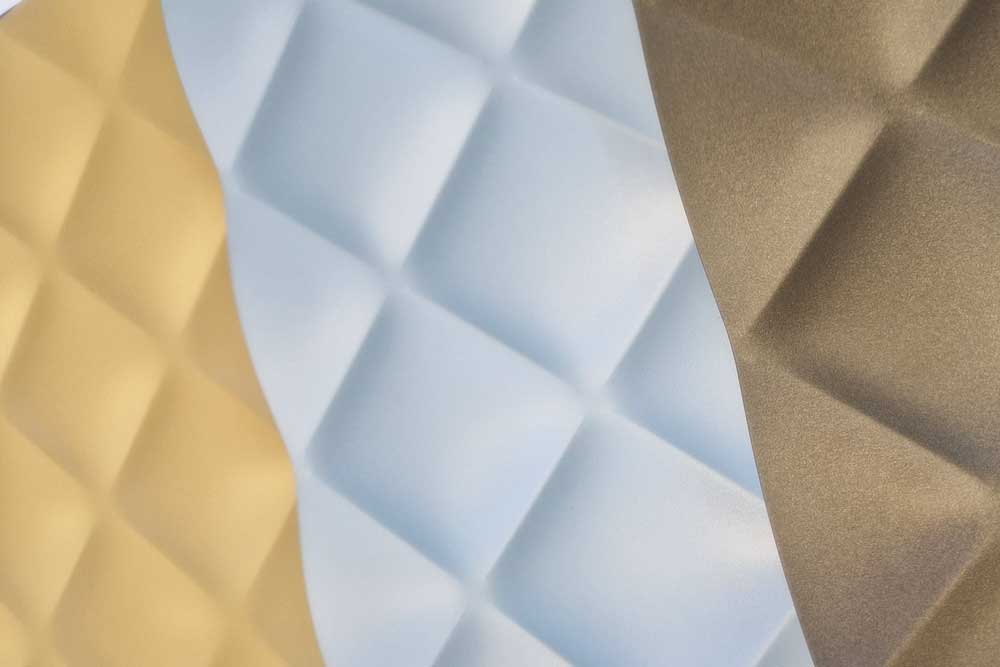 © ipcm
© ipcm“Working in the metal industry, I was familiar with TIGER and the quality of its products even before Emboss was stablished in 2018. Our collaboration, including the supply of TIGER paint products and the joint search for the best finishes for our 3D panels, started about two years ago. Today, we have an exclusive partnership for both standard finishes in RAL colours and special-effect finishes, such as, for example, those from its outdoor-specific TIGER Drylac® Series 68, which we find particularly interesting due to its super matte effect. We also use coatings from its 3D Metallics series, all super durable class 2 products. Finally, TIGER also supports us in developing customised and exclusive finishes, including, for example, in NCS colours, which are then produced in small batches upon customer approval. Emboss is not a powder specialist, but we do receive requests for the most diverse finishes: our products are special, so their finishing requirements are also special.
“In particular, for powder application on exterior cladding and façade panels, we rely on the expertise of Pintarelli Verniciature (Trento, Italy) and its certified pre-treatment and coating cycles, whereas for interior applications, we also rely on other contractors. Emboss always provides its contractors with the product code of the powder to be used (colour and chemical class) or, in some cases, purchases the required powders directly from TIGER.”
TIGER Drylac® Series 68 and 3D Metallics
“The matte and flat matte anodised-like colours of TIGER Drylac® Series 68 are particularly suitable for Emboss’ products because they enhance the play of light and shadow created by our 3D patterns,” notes Cesare Zilio. “They emphasise the sheet’s convexity, accentuating its three-dimensional effect. In addition, their super durable and highly weather resistant formulation makes them ideal for finishing cladding panels for outdoor applications.”
TIGER Drylac® Series 68 includes numerous matte or flat matte smooth finishes whose application is not limited to aluminium but can also be extended to steel and galvanised steel. They offer high colour consistency and homogeneity among batches, and they are super durable paints with GSB and/or QUALICOAT certifications, offering resistance for up to 10 years in Florida. TIGER Drylac® Series 68 3D Metallics also consists of GSB Florida 3-year and/or QUALICOAT class 2 certified super durable polyester coatings and combines the performance and one-coat application of the Series 68 with the high gloss and depth of effect typical of metallic liquid paints, turning each panel into an exclusive element.
Powder coatings’ unrivalled versatility
“Recently, we have also started assessing the use of liquid paints, starting with a pigmented clear coat for pre-anodised aluminium with a mirror-like finishing,” says Cesare Zilio.
“This would allow us to maintain a glossy appearance combined with colour, a special effect not obtainable with powders. At the same time, however, the advantages of powder coatings, such as the degree of customisation, uniformity, repeatability of finishes and colours, their inherent sustainability, and the one-coat application process, remain unrivalled and make this solution our preferred choice.”
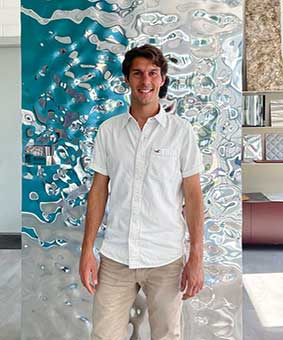 Cesare Zilio, founder of Emboss. © ipcm
Cesare Zilio, founder of Emboss. © ipcm